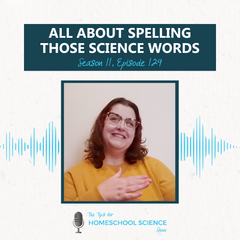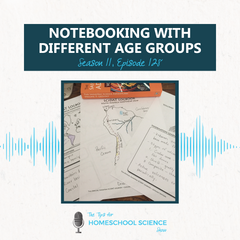FREE Shipping on all our products! (Please Note: Orders may experience a delay of a week or more in shipping due to the high volume of orders at this time of year.)
FREE Shipping on all our products! (Please Note: Orders may experience a delay of a week or more in shipping due to the high volume of orders at this time of year.)
Writing in Homeschool Science: Middle School and Beyond {Episode 13}
September 19, 2016 2 min read
Episode 13 – Writing in Homeschool Science: Middle School and Beyond
I am back with the second part of the writing in science series! We are looking at what writing in science should look like and how it progresses through the years.
In episode 13 of the Tips for Homeschool Science Show, I am sharing the second part of this two-part series on tips for writing in science. In this episode, we will look at the middle school years and beyond.
Watch the Video
Or listen to the audio
Share the Tips
If you found these homeschool science tips to be helpful, would you please take a moment to rate it on iTunes or Stitcher? This would help me tremendously in getting the word out, so that more ear buds are filled with science-teaching encouragement.
The Highlights
As your student matures, their writing and reading abilities increase and they are beginning to work independently. These students will still go through three stages of writing – fact-finding, organizing, and summarizing.
Stage 4 – Fact-finding
- Students are learning how to pull out the key facts from a selection they have read.
- Discussion time with these students is critical because talking over the material before writing will help the students to pull out the important information.
- In science, the students will read the selection on their own, discuss it, and write a list of six to eight facts from what they have read on a piece of paper.
Stage 5 – Organizing
- Students are working on organizing the key facts into an outline.
- In science, the students will read a selection on their own, create an outline from what they read, discuss it with you, and adjust as necessary.
- In the beginning, this will be a single level outline with the key facts. Their outlines will progress into multi-level outlines with the key facts and several supporting points underneath.
Stage 6 – Summarizing
- Students are learning how to write a connected, multi-paragraph summary on their own from what they have read.
- In science, these students will begin writing their own summaries from an outline.
- I prefer to have the students type their reports at this point as it seems to make them more willing to actually do the work.
Again, the main thing you are looking for is consistent progress year after year.
Additional Resources
Don’t miss the following book to gain a broad picture of the progression of writing skills:
- The Complete Writer by Susan Wise Bauer
Here are several articles to related to this show that you don't want to miss reading:
- Episode 12 – Writing in Homeschool Science: The Elementary Years
- 3 Content Related Tips for Notebooking
- What should middle school science look like?
- Science Essential #3 – Keeping a Record
A Quick Programming Note
You may have noticed that this show's title went from the Tips for Teaching Science at Home Show to the Tips for Homeschool Science Show. After some feedback, we decided to make the change so that the show would be easier to find. We are still sharing the same great tips and are so thankful you guys are enjoying them!
Also in {Podcast} The Tips for Homeschool Science Show
All About Spelling Those Science Words {Season 11, Episode 129}
March 25, 2024 7 min read

In this episode, we'll be interviewing Robin Williams from All About Spelling. Click "Read More" to listen is as we discuss tips and tricks for spelling all those science words!
How should you handle notebooking through the different ages? {Season 11, Episode 128}
March 18, 2024 3 min read

Writing in Science with a Well-Trained Mind (Interview) {Season 11, Episode 127}
March 11, 2024 16 min read

Click "Read More" to listen in as Susan Wise Bauer and Susanna Jarret join Paige to share tips and tools about the third key to teaching science!
Subscribe
Sign up to get the latest on sales, new releases and more …

